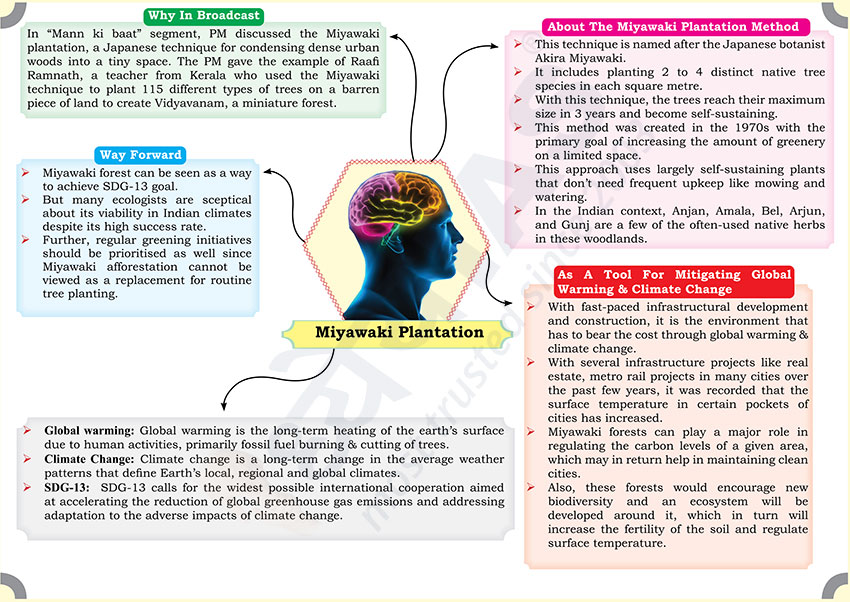Brain-booster /
10 Jul 2023
Brain Booster for UPSC & State PCS Examination (Topic: Miyawaki Plantation)

Why in Broadcast?
- In “Mann ki baat” segment, PM discussed the Miyawaki plantation, a
Japanese technique for condensing dense urban woods into a tiny space. The
PM gave the example of Raafi Ramnath, a teacher from Kerala who used the
Miyawaki technique to plant 115 different types of trees on a barren piece
of land to create Vidyavanam, a miniature forest.
About The Miyawaki Plantation Method
- This technique is named after the Japanese botanist Akira Miyawaki.
- It includes planting 2 to 4 distinct native tree species in each square
metre.
- With this technique, the trees reach their maximum size in 3 years and
become self-sustaining.
- This method was created in the 1970s with the primary goal of increasing
the amount of greenery on a limited space.
- This approach uses largely self-sustaining plants that don’t need
frequent upkeep like mowing and watering.
- In the Indian context, Anjan, Amala, Bel, Arjun, and Gunj are a few of
the often-used native herbs in these woodlands.
As A Tool For Mitigating Global Warming & Climate Change
- With fast-paced infrastructural development and construction, it is the
environment that has to bear the cost through global warming & climate
change.
- With several infrastructure projects like real estate, metro rail
projects in many cities over the past few years, it was recorded that the
surface temperature in certain pockets of cities has increased.
- Miyawaki forests can play a major role in regulating the carbon levels
of a given area, which may in return help in maintaining clean cities.
- Also, these forests would encourage new biodiversity and an ecosystem
will be developed around it, which in turn will increase the fertility of
the soil and regulate surface temperature.
- Global warming: Global warming is the long-term heating of the
earth’s surface due to human activities, primarily fossil fuel burning &
cutting of trees.
- Climate Change: Climate change is a long-term change in the
average weather patterns that define Earth’s local, regional and global
climates.
- SDG-13: SDG-13 calls for the widest possible international
cooperation aimed at accelerating the reduction of global greenhouse gas
emissions and addressing adaptation to the adverse impacts of climate
change.
Way Forward
- Miyawaki forest can be seen as a way to achieve SDG-13 goal.
- But many ecologists are sceptical about its viability in Indian climates
despite its high success rate.
- Further, regular greening initiatives should be prioritised as well
since Miyawaki afforestation cannot be viewed as a replacement for routine
tree planting.








